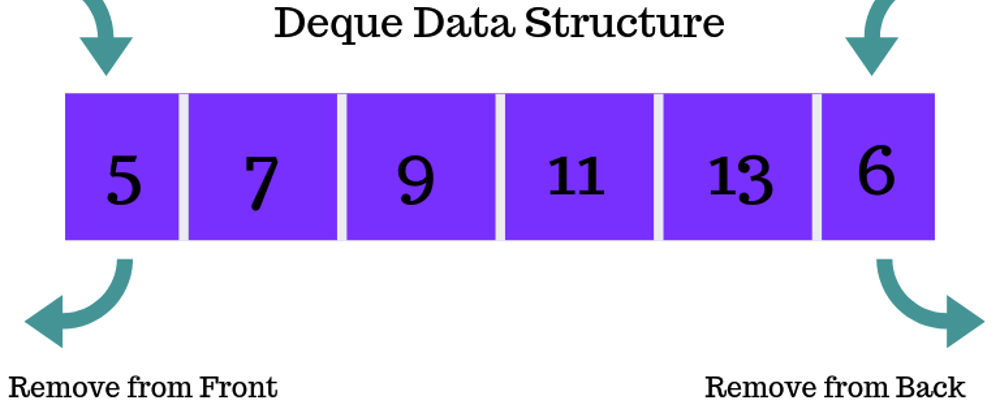Deque in Data Structures and Algorithms
In this tutorial, we will delve into deque (double-ended queue) in Data Structures and Algorithms. We'll explore what deque is, how it's used, and its implementation in various programming languages.
A deque, short for double-ended queue, is a versatile data structure that allows insertion and deletion of elements from both ends. This makes it suitable for scenarios requiring efficient manipulation at both the front and back, such as implementing a queue where elements need to be added and removed from both ends.
A deque supports the following operations:
- Insertion at Front: Adds an element to the front of the deque.
- Insertion at Back: Adds an element to the back of the deque.
- Deletion at Front: Removes and returns the element at the front of the deque.
- Deletion at Back: Removes and returns the element at the back of the deque.
- Peek at Front: Returns the element at the front of the deque without removing it.
- Peek at Back: Returns the element at the back of the deque without removing it.
- isEmpty: Checks if the deque is empty.
- Size: Returns the number of elements in the deque.
- Clear: Removes all elements from the deque.
Additionally, deques may support other operations such as searching, copying, iterating, merging, reversing, sorting, and mapping.

Here's an example of a deque in some programming languages:
- JavaScript
- Python
- TypeScript
- C++
- Java
class Deque {
constructor() {
this.items = [];
}
// Insertion at Front
addFront(element) {
this.items.unshift(element);
}
// Insertion at Back
addBack(element) {
this.items.push(element);
}
// Deletion at Front
removeFront() {
if (this.isEmpty()) {
return "Underflow";
}
return this.items.shift();
}
// Deletion at Back
removeBack() {
if (this.isEmpty()) {
return "Underflow";
}
return this.items.pop();
}
// Peek at Front
peekFront() {
return this.items[0];
}
// Peek at Back
peekBack() {
return this.items[this.items.length - 1];
}
// isEmpty operation
isEmpty() {
return this.items.length === 0;
}
// Size operation
size() {
return this.items.length;
}
// Clear operation
clear() {
this.items = [];
}
// Print operation
print() {
console.log(this.items);
}
}
// Using the deque
let deque = new Deque();
deque.addFront(1);
deque.addBack(2);
deque.addFront(3);
deque.print(); // Output: [3, 1, 2]
deque.removeFront();
deque.print(); // Output: [1, 2]
console.log(deque.peekBack()); // Output: 2
console.log(deque.isEmpty()); // Output: false
console.log(deque.size()); // Output: 2
deque.clear();
deque.print(); // Output: []
from collections import deque
# Using the deque
deque = deque()
deque.appendleft(1)
deque.append(2)
deque.appendleft(3)
print(deque) # Output: deque([3, 1, 2])
deque.popleft()
print(deque) # Output: deque([1, 2])
print(deque[-1]) # Output: 2
print(len(deque) == 0) # Output: False
print(len(deque)) # Output: 2
deque.clear()
print(deque) # Output: deque([])
class Deque<T> {
private items: T[] = [];
// Insertion at Front
addFront(element: T): void {
this.items.unshift(element);
}
// Insertion at Back
addBack(element: T): void {
this.items.push(element);
}
// Deletion at Front
removeFront(): T | string {
if (this.isEmpty()) {
return "Underflow";
}
return this.items.shift();
}
// Deletion at Back
removeBack(): T | string {
if (this.isEmpty()) {
return "Underflow";
}
return this.items.pop();
}
// Peek at Front
peekFront(): T | undefined {
return this.items[0];
}
// Peek at Back
peekBack(): T | undefined {
return this.items[this.items.length - 1];
}
// isEmpty operation
isEmpty(): boolean {
return this.items.length === 0;
}
// Size operation
size(): number {
return this.items.length;
}
// Clear operation
clear(): void {
this.items = [];
}
// Print operation
print(): void {
console.log(this.items);
}
}
// Using the deque
let deque = new Deque<number>();
deque.addFront(1);
deque.addBack(2);
deque.addFront(3);
deque.print(); // Output: [3, 1, 2]
deque.removeFront();
deque.print(); // Output: [1, 2]
console.log(deque.peekBack()); // Output: 2
console.log(deque.isEmpty()); // Output: false
console.log(deque.size()); // Output: 2
deque.clear();
deque.print(); // Output: []
#include <iostream>
#include <deque>
using namespace std;
// Using the deque
deque<int> deque;
deque.push_front(1);
deque.push_back(2);
deque.push_front(3);
for (int element : deque) {
cout << element << " ";
}
cout << endl; // Output: 3 1 2
deque.pop_front();
for (int element : deque) {
cout << element << " ";
}
cout << endl; // Output: 1 2
cout <<```cpp
deque.back() << endl; // Output: 2
cout << (deque.empty() ? "true" : "false") << endl; // Output: false
cout << deque.size() << endl; // Output: 2
deque.clear();
for (int element : deque) {
cout << element << " ";
}
cout << endl; // Output:
import java.util.ArrayDeque;
import java.util.Deque;
public class Main {
public static void main(String[] args) {
// Creating a deque in Java
Deque<Integer> deque = new ArrayDeque<>();
// Using the deque
deque.addFirst(1);
deque.addLast(2);
deque.addFirst(3);
System.out.println(deque); // Output: [3, 1, 2]
deque.removeFirst();
System.out.println(deque); // Output: [1, 2]
System.out.println(deque.peekLast()); // Output: 2
System.out.println(deque.isEmpty()); // Output: false
System.out.println(deque.size()); // Output: 2
deque.clear();
System.out.println(deque); // Output: []
}
}
Conclusion
In this tutorial, we explored deque (double-ended queue) in Data Structures and Algorithms. We discussed its features, operations, and provided implementations in JavaScript, Python, TypeScript, C++, and Java. Deque is a powerful data structure that offers efficient insertion and deletion at both ends, making it suitable for various applications where elements need to be manipulated dynamically.
Now, armed with the knowledge of deque, you can enhance your understanding of data structures and algorithms and apply them to solve complex problems effectively.
This tutorial provides a detailed overview of deque, including its operations and implementations in different programming languages. It should serve as a valuable resource for anyone looking to understand and utilize deque in their projects.